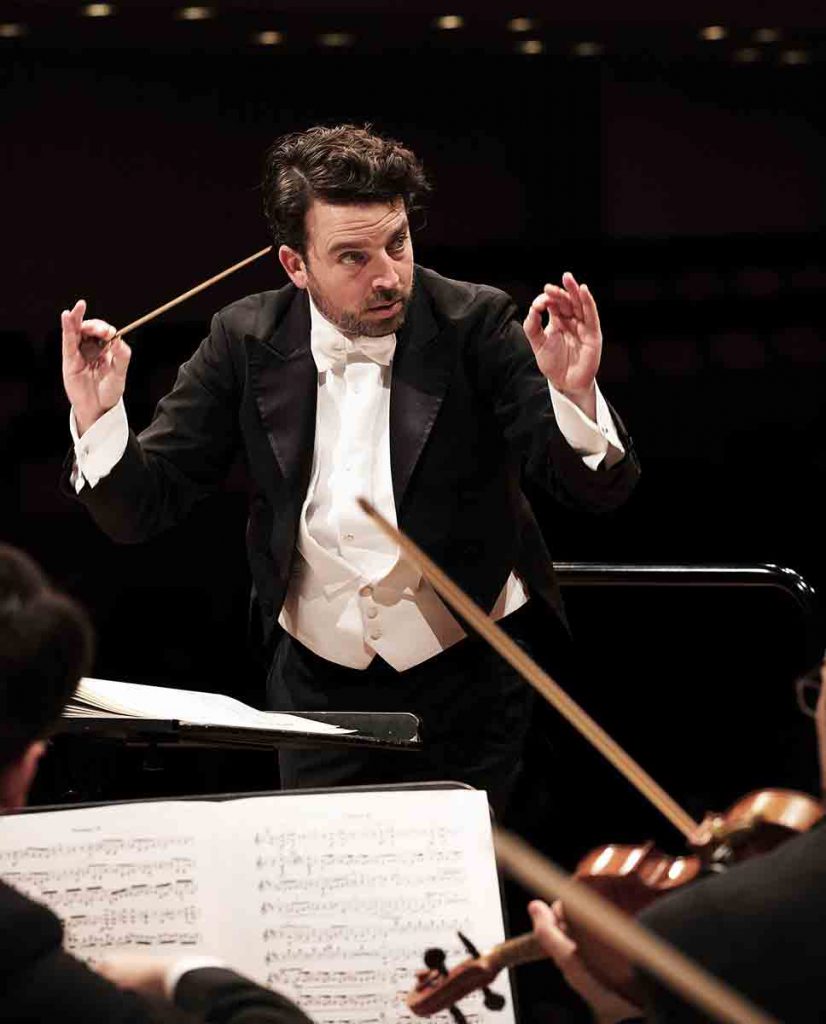Gaffigan, Dallas Symphony and Chorus bring out the dark brilliance of “The Bells”

James Gaffigan conducted the Dallas Symphony Orchestra in music of Liszt, Tchaikovsky and Rachmaninoff Thursday night.
Heavy-duty romanticism reigned at the Meyerson Symphony Center Thursday night as guest conductor James Gaffigan returned to the podium of the Dallas Symphony Orchestra for his second appearance here in less than two years. As in his performances with the orchestra in November 2017, Gaffigan focused on Tchaikovsky and Rachmaninoff, this time with unusual choices from those two Russian titans.
Rachmaninoff’s The Bells opened the evening with the first-ever Dallas performance of that century-old work. A hybrid of cantata, symphony, and song cycle, The Bells features a Russian translation of excerpts from American poet Edgar Allan Poe’s eponymous poem; Poe’s evocative images inspired, in Rachmaninoff, a wide-ranging exploration of the timbral possibilities of chorus and orchestra, with colorful textures reminiscent of Rimsky-Korsakov and Borodin. Gaffigan reveled in the work’s array of orchestral effects, all the while carefully pacing the dramatic drive.
Once again, the Meyerson Symphony Center proved an ideal room for large-scale choral-orchestral productions. The 200-voice Dallas Symphony Chorus, trained by chorus director Joshua Habermann, produced the required combination of precision and a gorgeous roar of choral sound on their entrance in the first movement, “The Silver Sleigh Bells.” Russian tenor Sergey Skorokhodov provided a clear, glowing focal point as soloist in this sometimes glittering, sometimes shadowy winter landscape.
In the second movement, “The Mellow Wedding Bells,” the young Armenian-born soprano Mané Galoyan, currently based in Houston, gave Dallas audiences a taste of her dark-textured vocal qualities and dramatic flair, obvious even in this concert performance. Other highlights of this moon-bathed nocturne included a passage of fluid cantelina-like counterpoint between the violins and the cellos, and an ear-catching moment in which the women’s voices floated above the orchestra near the end. In this movement in particular, Gaffigan repeatedly created the sense of the soloist and the chorus emerging magically out of the orchestral texture.
The third movement, “The Loud Alarm Bells,” is also a night piece—but a hellish one, describing a burning building via complex cross-rhythms and a superbly controlled accelerando at a key point.
David Matthews gave an impressively shaped rendition of the mournful English horn solo that opens the final movement, “The Mournful Iron Bells,” and Ukrainian Andrei Bondarenko brought a strikingly resonant baritone to the solo role. The sung text of this movement closes with a hopeless depiction of “the quiet of the tomb”: Rachmaninoff seized the word “quiet” to produce a serene coda, however, for a work that this listener wouldn’t mind hearing more often in live performance.
After intermission, pianist Yefim Bronfman joined Gaffigan and the orchestra for Liszt’s Piano Concerto No. 2 in A, lingering calmly in the deceptively reflective opening passage before diving headlong into the work’s pianistic tempests. Bronfman is a clear master of the whirlwinds of notes here as well as of the chameleon mood shifts; he and Gaffigan partnered to create the apt sense of Liszt’s gigantic ego distilled into a twenty-minute essay in piano technique and showmanship. Bronfman obliged the enthusiastic ovation by moving, for encore, into the completely different universe of the gentle trills of Scarlatti’s Sonata in C minor, K. 11.
Hence immediately to the one odd choice of the evening: Tchaikovsky’s 1812 Overture, including the choral parts added (at the request of Eugene Ormandy) by American conductor and arranger Igor Buketoff. The Overture, depicting the battle between French and Russian troops in 1812, has for some reason become a standard part of outdoor Independence Day concerts in America, usually with cannon blasts and fireworks.
Gaffigan at first treated the work with slightly more seriousness than it deserves, and it was interesting to actually notice the quite decent second lyrical theme as well as the Russian folk tune, here delivered in unison by the sopranos and altos of the chorus. For that final deafening explosion (with the cannon blasts simulated by a large bass drum), Gaffigan threw subtlety and balance to the wind, producing a disappointingly bombastic close to an otherwise admirable concert.
The program will be repeated at Meyerson Symphony Center at 7:30 p.m. Friday and Saturday. mydso.com; 214-692-0203.